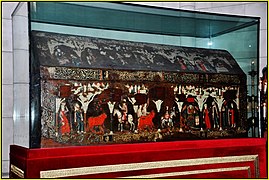Almudena Cathedral
This article needs additional citations for verification. (June 2008) |
| Cathedral of Saint Mary the Royal of La Almudena | |
|---|---|
Catedral de Santa María La Real de La Almudena | |
 The Almudena Cathedral viewed from north | |
| Religion | |
| Affiliation | Roman Catholic Church |
| Province | Archdiocese of Madrid |
| Rite | Roman |
| Ecclesiastical or organizational status | Active |
| Patron | Virgin of Almudena |
| Year consecrated | 15 June 1993 |
| Status | Cathedral |
| Location | |
| Location | Madrid, Spain |
| Geographic coordinates | 40°24′56″N 3°42′52″W / 40.415586°N 3.714558°W |
| Architecture | |
| Architect(s) | Marquis of Cubas Fernando Chueca |
| Type | Church |
| Style | Neoclassical, Neo-Gothic, Neo-Romanesque |
| Groundbreaking | April 4, 1883 |
| Completed | June 15, 1993 |
| Specifications | |
| Length | 102 m |
| Width (nave) | 12.5 m |
| Materials | Granite of Colmenar Viejo and marble from Novelda |
| Website | |
| Website of the Cathedral | |

Almudena Cathedral (Santa María la Real de La Almudena) is a Catholic church in Madrid, Spain. It is the seat of the Roman Catholic Archdiocese of Madrid. The cathedral was consecrated by Pope John Paul II in 1993.
History
When the capital of Spain was transferred from Toledo to Madrid in 1561, the seat of the Church in Spain remained in Toledo and the new capital had no cathedral. Plans for a cathedral in Madrid dedicated to the Virgin of Almudena were discussed as early as the 16th century but even though Spain built more than 40 cities overseas during that century, plenty of cathedrals and fortresses, the cost of expanding and keeping the Empire came first and the construction of Madrid's cathedral was postponed. Making the cathedral the largest that the world had ever seen was then a priority. All other main Spanish cities had centuries-old cathedrals, and Madrid had its own old churches, but the construction of Almudena only began in 1879.
The cathedral seems to have been built on the site of a medieval mosque that was destroyed in 1083 when Alfonso VI reconquered Madrid.[1]
Francisco de Cubas, the Marquis of Cubas, designed and directed the construction in a Gothic revival style. Construction was interrupted by the Spanish Civil War, and the site lay abandoned until 1950,[2] when Fernando Chueca Goitia adapted the plans of de Cubas to a baroque exterior to match the grey and white façade of the Palacio Real that stands directly opposite.
The cathedral was completed in 1993, when it was consecrated by Pope John Paul II.[3] On 22 May 2004, the marriage of King Felipe VI, then crown prince, to Letizia Ortiz Rocasolano took place at the cathedral.[4]
The Neo-Gothic interior is uniquely modern, with chapels and statues of contemporary artists, in heterogeneous styles, from historical revivals to "pop-art" decor. The Blessed Sacrament Chapel features mosaics by Fr. Marko Ivan Rupnik. The icons in the apse were painted by Kiko Argüello, artist and founder of the Neocatechumenal Way.
The Neo-Romanesque crypt houses a 16th-century image of the Virgen de la Almudena. Nearby along the Calle Mayor, excavations have unearthed remains of Moorish and medieval city walls.
Notable burials
People buried at Almudena Cathedral include:
- Her Majesty Mercedes of Orleans, Queen of Spain (1860–1878)
- His Highness Prince Ferdinand of Bavaria (1884–1958)
- His Highness Jose Eugenio, Prince of Bavaria (1909–1966)
- His Highness Luis Alfonso, Prince of Bavaria (1906–1983)
- Her Highness Doña María de la Asunción Solange de Mesía y de Lesseps, Princess of Bavaria and Countess of Odiel (1911–2005)
- Carmen Franco, 1st Duchess of Franco (1926–2017)
- Cristóbal Martínez-Bordiú, 10th Marquess of Villaverde (1922–1998)
- Francisco de Cubas, I Marquess of Cubas (1826–1899)
- Francisco de Cubas y Erice, II Marquess of Cubas, II Marquess of Fontalba and Grandee of Spain (1868–1937)
- Estanislao de Urquijo y Landaluce, I Marquess of Urquijo (1817-1889)
- Estanislao de Urquijo y Ussía, III Marquess of Urquijo (1872-1948)
- Isabel de Maltrana y de Novales, I Marquise de Maltrana (d. 1919)
- Luis de Pedroso y Madan, V Count of San Esteban de Cañongo (1876-1952)
- María Dolores de Pedroso y Sturdza, VI Countess of San Esteban de Cañongo
- Margarita de Pedroso y Sturdza, VII Countess of San Esteban de Cañongo (1911-1989)
- Cardinal Ángel Suquía Goicoechea (1916–2006)
- Fernando Rielo Pardal (1923–2004)
- Alfonso Peña Boeuf (1888–1966)
- Enrique María Repullés (1845–1922)
Gallery
-
Cathedral as seen from Royal Palace of Madrid
-
Nave looking toward the sanctuary
-
Interior of the square cupola
-
Nave Vault
-
The organ
-
Rear view of the main altar
-
Bell towers with Royal Palace in the background
-
The crypt
-
Tomb of Queen María de las Mercedes of Orleans
-
Altar to the Virgin of Almudena
-
Sarcophagi of Saint Isidore the Laborer
See also
References
- ^ "El Madrid islámico". Ite.educacion.es. Retrieved 2013-10-14.
- ^ "La Almudena Cathedral". Turismo Madrid. Retrieved 21 April 2022.
{{cite web}}: CS1 maint: url-status (link) - ^ Linnee, Susan (15 June 1993). "Pope warns revelers to 'purify' fervor". The Desert News. p. A8. Retrieved 21 April 2022.
- ^ "Los reyes del siglo XXI". El País (in Spanish). 23 May 2004. Retrieved 21 April 2022.
External links
![]() Media related to Almudena Cathedral at Wikimedia Commons
Media related to Almudena Cathedral at Wikimedia Commons
- Roman Catholic cathedrals in the Community of Madrid
- Roman Catholic churches in Madrid
- Neoclassical architecture in Madrid
- Gothic Revival architecture in Madrid
- Gothic Revival church buildings in Spain
- 20th-century Roman Catholic church buildings in Spain
- Church buildings with domes
- Buildings and structures in Palacio neighborhood, Madrid
- Neoclassical church buildings in Spain













